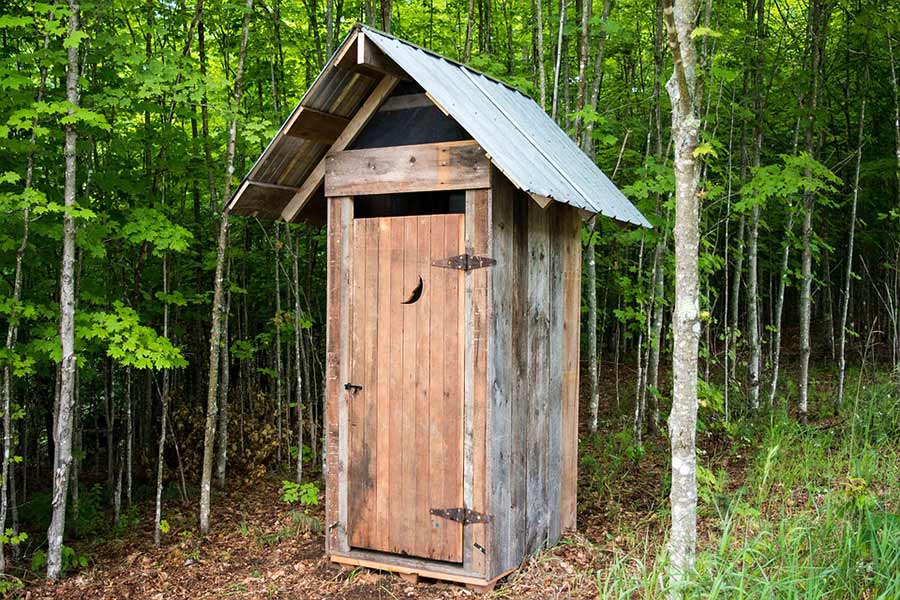The outhouse, a structure that was once a common sight, is now becoming a relic of the past. Here’s a brief history of how the outhouse came to be.

The Earliest Outhouses
Historians and archaeologists are usually excited to explore an old outhouse because it can give them clues about the lives of the former inhabitants. For example, people sometimes left bottles or relics in the outhouse, which can reveal clues about historical context. Also, fossilized excrement can provide clues about the diet and health of past users.
The outhouse has endured for this long, which is impressive considering the first outhouse was thought to have been built some 500 years ago. Since latrines were highly unsanitary around the 1500s, it made sense to designate a specific spot for doing personal business. The earliest outhouses were located 50 to 100 yards away from the home and were small huts that had little more than a hole in the floor. Inside the floor was a small tin or bucket that caught the waste and it had to be emptied daily by one lucky winner.
Interestingly enough, flush toilets began to emerge around this time, but the idea did not gain traction at first. Instead, people preferred to use their outhouses or “necessaries,” as they were sometimes called.
Outhouses Become Remnants of the Past
There are still old outhouses that exist today that reflect the trends of the time. For example, anyone who has seen a star or a moon shape cut out of the outhouse door might wonder what that’s all about. This was common among American outhouses during the day and signified whether the structure was for men or women. A moon meant that it was a female-only outhouse as the moon was a symbol of the Roman goddess Luna. The sun, which represented the Greek god Apollo, meant that it was a men’s outhouse. Modern outhouses might adopt this practice, although it is usually more for decorative effect than to designate gender for the outhouse.
While many people may think of outhouses as being used only in rural areas where there wasn’t a reliable water source, outhouses used to be popular in both the countryside and in cities. However, due to large numbers of people using the outhouses in the cities, officials were led to decrease their use as it posed a greater public health risk.
In contrast, the outhouses in the countryside remained and they are the typical outhouses that most people think of today. Constructed of wood, they were easy to relocate if need be and they were typically well built and painted for added durability. The interior hole in an outhouse was between three and six feet and there might be more than one hole if the outhouse was catering to a family.
“The Eleanor”
The presidency of Franklin D. Roosevelt brought improvements to American outhouses and the effort was adamantly supported by First Lady Eleanor Roosevelt. The initiative was called the Work Projects Administration and part of their mission was to replace dilapidated outhouses in the rural United States. With three workers and $5, the Administration could construct a new outhouse in 20 hours. These new and improved outhouses included proper ventilation, privacy, and flooring too. The Work Projects Administration successfully completed two million outhouses during its run. The First Lady’s commitment to the cause led to outhouses earning the nickname “The Eleanor.”
Two-Story Outhouses
It may be hard to believe but two-story outhouses did exist. There were only a handful of them and one of the most famous is in Gays, Illinois. The two-story outhouse makes sense in this case as it was built to accommodate the two-story apartment buildings situated next to it. The second-story apartments sat above a general store and the outhouse made it more convenient for employees and tenants to have access. The upstairs portion of the outhouse was built a little further back so that its contents didn’t spill into the bottom floor.
There are still tens of thousands of outhouses in America, not to mention the outhouses that exist in other countries. While society has moved on to more upscale portable toilets and public restrooms, there is something nostalgic about finding an outhouse out in the country.
Sources:
whoinventedit.net/who-invented-the-outhouse.html
lancasterfarming.com/pondering-the-privy-a-history-of-outhouses
